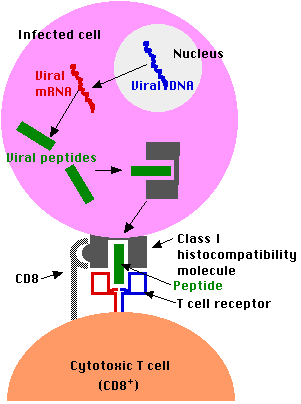The bone marrow produces all the blood cells: red blood cells, white blood cells (also called leukocytes), and platelets. The most abundant of the white blood cells are the lymphocytes.
Although mature lymphocytes all look pretty much alike, they are extraordinarily diverse in their functions. The most abundant lymphocytes are:| Link to drawing showing the organs of the immune system. (52K) |
Each B cell and T cell is specific for a particular antigen. What this means is that each is able to recognize and bind to a particular molecular structure.
The specificity of binding resides in a receptor for antigen:
| How antigen receptor diversity is generated |

The complex has been compared to a "hot dog in a bun".
 Most of the T cells in the body belong to one of two subsets. These are distinguished by the presence on their surface of one or the other of two glycoproteins designated:
Most of the T cells in the body belong to one of two subsets. These are distinguished by the presence on their surface of one or the other of two glycoproteins designated:

The best understood CD8+ T cells are cytotoxic T lymphocytes (CTLs). They secrete molecules that destroy the cell to which they have bound. This is a very useful function if the target cell is infected with a virus because the cell is usually destroyed before it can release a fresh crop of viruses able to infect other cells.
An example will show the beauty and biological efficiency of this mechanism.
Every time you get a virus infection, say influenza (flu), the virus invades certain cells of your body (in this case cells of the respiratory passages). Once inside, the virus subverts the metabolism of the cell to make more virus. This involves synthesizing a number of different macromolecules encoded by the viral genome.
In due course, these are assembled into a fresh crop of virus particles that leave the cell (often killing it in the process) and spread to new target cells.
Except while in transit from their old homes to their new, the viruses work inside of your cells safe from any antibodies that might be present in blood, lymph, and secretions.
But early in the process, infected cells display fragments of the viral proteins in their surface class I molecules. CTLs specific for that antigen will be able to bind to the infected cell and often will be able to destroy it before it can release a fresh crop of viruses.
In general, the role of the CD8+ T cells is to monitor all the cells of the body, ready to destroy any that express foreign antigen fragments in their class I molecules.
These CD4+ cells bind to antigen presented by antigen-presenting cells (APCs) like phagocytic macrophages and dendritic cells. The T cells then release lymphokines that attract other cells to the area. The result is inflammation: the accumulation of cells and molecules that attempt to wall off and destroy the antigenic material (an abscess is one example, the rash following exposure to poison ivy is another).
These CD4+ cells, called helper T cells, bind to antigen presented by B cells (as shown above). The result is the development of clones of plasma cells secreting antibodies against the antigenic material.
| Link to a discussion of antigen-presenting cells. |
| Link to a discussion of helper T cells. |
AIDS provides a vivid and tragic illustration of the importance of CD4+ T cells in immunity. The human immunodeficiency virus (HIV) binds to CD4 molecules and thus is able to invade and infect CD4+ T cells. As the disease progresses, the number of CD4+ T cells declines below its normal level of about 1000 per microliter (µl). (A partial explanation for this may be the unceasing efforts of the patient's CD8+ T cells to destroy the infected CD4+ cells. However, it turns out that only a small fraction of the patients CD4+ T cells are infected at any given time. How uninfected CD4+ cells may be induced to commit suicide is discussed in the page on apoptosis.)
When the number of CD4+ T cells drops below 400 per microliter, the ability of the patient to mount an immune response declines dangerously. Not only does the patient become hypersusceptible to pathogens that give all of us grief but also to microorganisms, especially viruses and fungi, that normally inhabit our tissues without harming us. Eventually the patient dies of these opportunistic infections.
| Welcome&Next Search |